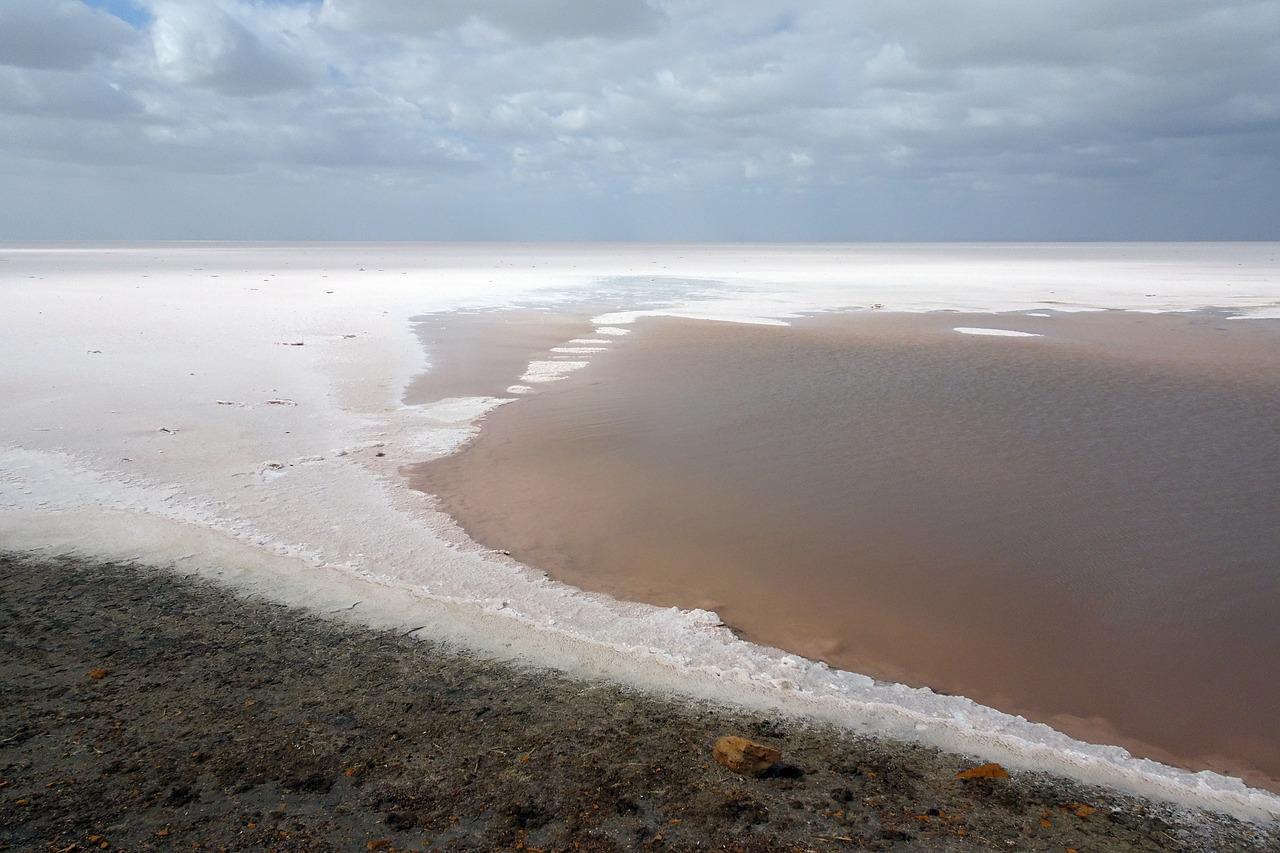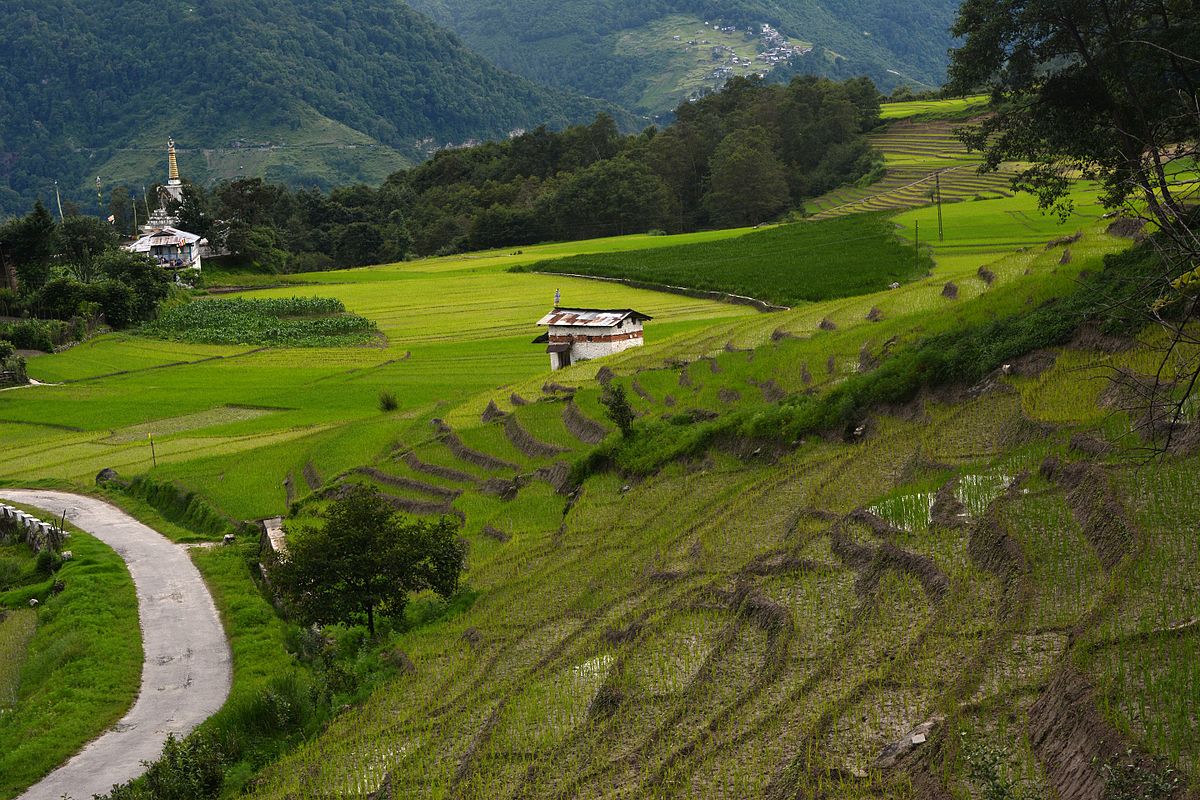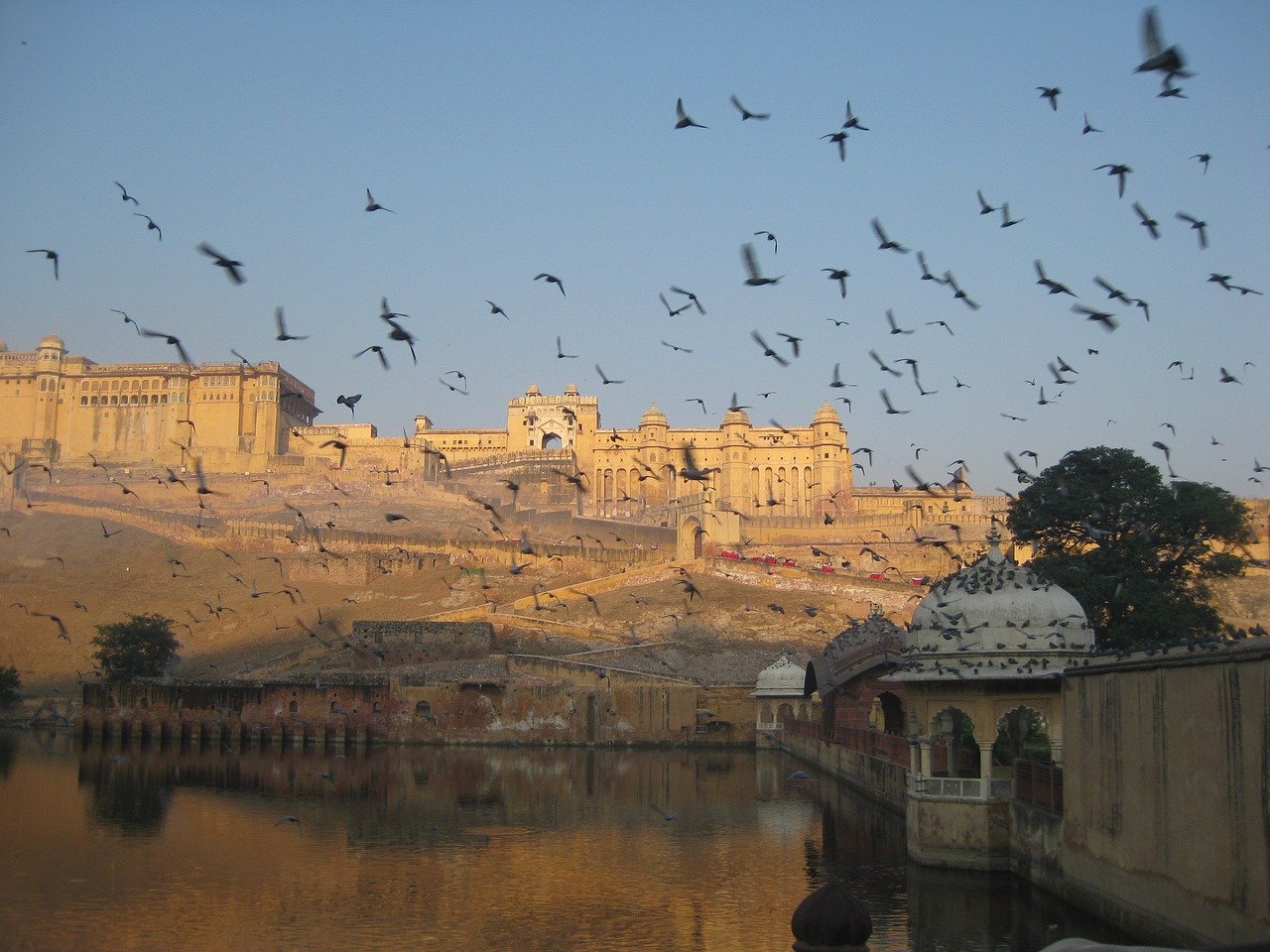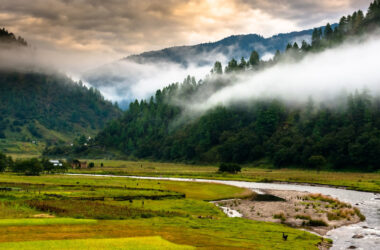Literally, an island that resembles the shape of a tortoise, Kutch is a former princely state of India that retains its grandeur from the past. With its vast expanse of the white salt desert, Kutch is perhaps one of the most beautiful yet surreal places in India. The place comes to life during winters when Rann Mahotsav is held everywhere from December-February with huge camp settlements with cultural events, functions, and adventure activities like hot-air ballooning.
Kutch is also the largest district in India with a very low population density. Also, Kutch is located on the Indo-Pakistan border and you can see parts of Pakistan from Kutch. Kutch is also famous for craft and embroidery works, Flamingo Sanctuary, and Wild Ass Sanctuary. Bhuj is an ideal starting point for a trip to the Rann of Kutch. The beautiful beaches of Mandvi near Bhuj are also totally worth visiting during your trip to Kutch. Do not miss to visit the ancient city of Dholavira.
Places To Visit In Kutch
- Great Rann of Kutch
The Great Rann of Kutch is a large area of salt marshland, located in the Kutch district in the western state of Gujarat, India. The vast expanse is located in the Thar Desert and is made up of salt marshes. The sunset in the Great Rann of Kutch is a treat to the eyes after exploring this region.
The region is divided into two parts, the Great Rann of Kutch and the Little Rann of Kutch, and contains vast deposits of salt in the desert. These deposits are known to produce a mirage, and many pilgrims have shared stories about seeing optical illusions that seem as good as real.
The region has been so famous for its natural beauty that it was featured in many movies in India, for example – Refugees, Magadheera, Goliyon Ki Raasleela Ram Leela, Sarayanodu, etc. It has also been mentioned in several books, including the Booker Prize winner. The novel, Midnight’s Children, by Salman Rushdie. The name Great Rann of Kutch, is derived from the word “Rann” which in Hindi means desert and the district in which it is situated. It is considered to be one of the largest salt deserts in the whole world.
- Kutch Desert Wildlife Sanctuary
Located 100 km from Bhuj, the Kutch Desert Wildlife Sanctuary is one of the largest periodic saline wetlands in the world. Colloquially known as “Flamingo City”, it is the largest wildlife sanctuary with a vast expanse of approximately 7505.22 sq km.
Situated near the submerged 5000-year-old Harappan civilization of Dholavira, the Kutch Desert Wildlife Sanctuary also cites various fossils.
The excessive salt deposits here give the sanctuary a pure white surface which attracts more uniqueness. Although the Kutch Desert Wildlife Sanctuary is located on the Indo-Pak border, some parts of the sanctuary are restricted to the public. There are also some BSF areas.
- Dholavira
It is one of the most remarkable excavations of the Indus Valley Civilization which was one of the most developed civilizations around 4500 years ago.
History itself witnesses! A visit to the site tells the story of the 7 Stages of Civilization and is considered one of the grandest cities of its time. It is one of the 5 largest Harappan sites and one of the most prominent archaeological sites in India belonging to the Indus Valley Civilization. The place was occupied from about 2650 BC to 1450 BC with a brief abandonment period.
- Kutch Museum
The oldest museum in Gujarat, Kutch Museum boasts its collection of extinct Kutch script and ancient coins. Tribal artifacts are also a part of the museum, along with many other types of objects on display such as embroidery, paintings, weapons, musical instruments, sculptures, and precious metals.
- Kutch Bustard Sanctuary
Locally known as Lala Prajan Sanctuary, the primary objective of the Kutch Bustard Sanctuary is to conserve the Great Indian Bustard. It is located in Jakhau village of Naliya Taluka of Gujarat. Among the many other different varieties of wildlife that can be found within the reserve, there are three different types of bustards in the sanctuary.
The sanctuary covers an area of just over 2 sq km but still has some outstanding species including Harrier, Common Crane, Black Partridge, Sand Grouse, Black and Gray Francolin, Spotted and Indian Sandgrouse, Quail, Lark, Shrik, Corsair included. , Plover, Imperial Eagle, Flamingo, Heron, Heron, Sandpiper, etc. Some other wild animals that are present here are wolf, caracal, desert cat, jackal, striped hyena, fox, mongoose, blue bull, chinkara, spiny-tailed lizard, and various types of snakes.
- Mandvi Beach, Bhuj
Located in the Kutch region of Gujarat, Mandvi Beach is a pristine and serene beach that is one of the most popular holiday destinations in the region. Apart from being a relaxing beach location, Mandvi beach is popular for its camping and water sports facilities.
Standing near the Vijay Vilas Palace Estate in Bhuj, Mandvi Beach is a secluded and undiscovered beach destination with clear waters and beautiful views. Take a long walk along the shore as you watch the sunset on the horizon, or go bird watching and discover its beauty through the fauna of Kutch.
Another activity here is the camel ride, which takes you around the entire property as you spin up and down on the back of this majestic animal, or practice some yoga to the tunes of the gentle sea. Its most attractive quality with its serene surroundings makes Mandvi Beach a charming rendezvous with nature and its beauty.
- Shopping in Kutch
Kutch is famous for its Great Rann of Kutch, a vast white salt desert that lies within the boundaries of the Thar Desert. The endless white fields of salt are indeed a wonder India is blessed with. As much as we know the Rann of Kutch for its great salt desert, it is also known for its artistic handicrafts. Most of the small villages in the Kutch district are engaged in the craft business, producing some of the finest artifacts which they put up for sale during the Rann Utsav.
Kutch is a famous tourist destination, and its market has a lot to offer to shoppers, especially those who admire precious artifacts. The whole area is dotted with artisan villages each with a unique style of handicrafts. Kutch is most famous for its embroidery.
There are many tribes who prepare various handmade items with the famous art of their region. More than 11,000 women and 65 villages are engaged in the handicraft business. You can buy embroidered sheets, clothes, jackets, sarees, carpets, etc. from the villages of Kutch.
- Aina Mahal
The Aina Mahal palace, or the ‘Hall of Mirrors’ was built during the flamboyant rule of Lakhpatji in the mid-18th century. The responsibility of engineering, architecture, and ornamentation lay with Ram Singh Malam – an artist’s genius who trained in Europe for 17 years but returned to India in search of name and fame. She was asked by the king to build the palace of her dreams and thus Aina Mahal came into existence.
However, what once stood proudly with gleaming glasses, antique clocks, and exotic tile works, was shaken and disoriented in the 2001 Bhuj earthquake. The damage was tragic, but it has now been repaired and rebuilt for people to come back safely. The Aina Mahal is in the northeast corner of Hamirsar Lake, which is easily walkable from most of Bhuj. Be sure to explore the rest of the complex outside the palace, with its beautifully carved doors, elaborate window boxes, and balconies.
- Narayan Sarovar Sanctuary
Narayan Sarovar Sanctuary, located at a distance of 125 km from Bhuj, is spread over an area of about 444 sq. km. and is one of the distinctive ecosystems in the Kutch district of Gujarat state. Also known as Narayan Sarovar Chinkara Sanctuary, it is home to several mammals such as the chinkara, the endangered Indian wolf, wild cats, desert foxes, honey badger, and wild boar.
Tourists can also spot about 184 different species of birds in this sanctuary which include waterfowl, black pheasant, hubara bustard, lesser florican, and great Indian bustard. Around 252 types of plants can be found in the sanctuary like gorad, babul, kerado, and more.
- Prag Mahal
Located on the outskirts of the ethnic city of Bhuj, Prague Palace is one of the architectural marvels in India. Built in the 19th century, it is set next to the popular Aina Mahal and is located in the heart of the city, making it easily accessible. The grand palace has Gothic-style windows and Corinthian columns around it. The grand palace has the second tallest clock tower in the country which offers a wonderful view from the top.
Grand and beautiful in itself, the resplendent palace is mostly made of red sandstone. The walls are intricately carved with beautiful art, and the most amazing thing is the jali work on the jharokhas, which are exquisite in appearance. Prague Mahal has also been very famous in Bollywood and has been a part of many Bollywood blockbusters including Lagaan, Hum Dil De Chuke Sanam, and several Gujarati films.
Similar Articles
Frequently Asked Questions About Kutch
Q. What is Kutch famous for?
A – Kutch is famous for its handicrafts, hills, white desert, beautiful virgin sea beaches, various forts, and above all Dholavira, one of the five largest Harappan sites and one of the most prominent archaeological sites in India belonging to the Indus Valley Civilization. is one.
Q. Is Kutch in India or Pakistan?
A – The Rann of Kutch is located mostly in the Indian state of Gujarat, specifically the Kutch district, for which it is named. Some parts are spread over the Sindh province of Pakistan. The word Rann means “desert”. The Rann of Kutch covers an area of approximately 26,000 square kilometers (10,000 sq mi).
Q. What is the best time to visit Kutch?
A – Winter is the best time to visit Kutch. The temperature during these months ranges between 25 to 12 degree Celsius and makes the weather perfect for sightseeing. This is also the best time to visit the Rann of Kutch Festival.
Q. Is Kutch open for tourists?
A – The desert of Kutch is divided into the Little Rann which is 4,950 sq km and the Great Rann which is 7,850 sq km of desert. Together they form the largest surrounding area of the wildlife area in India. Tent City will be open for visitors till February 28.
Q. Why is the sand of Kutch desert white?
A – The Rann of Kutch and the state of Gujarat are the largest salt producing regions in India. During the monsoon months, the Arabian Sea fills the Rann with sea water. When the water recedes around October, salt farmers dig wells and pump sparkling groundwater into square fields where the white salt crystals naturally evaporate.
Q. How many days are enough for Kutch?
A – 3 nights and 4 days are good for exploring the Kutch region. Each day you can visit Black Hills and White Rann, on the second day Mandvi and Sarodings, on the third day Lakhpat, Narayansarovar-Koteeshwar, Mata Na Madh etc. and keep the last day for Bhuj and surroundings.
Q. Is Rann Utsav Worth It?
A – If you prefer more comfort in an accommodation of your choice, then Rann Utsav is definitely the best time to visit the Rann of Kutch! Sightseeing: Rann Utsav packages come with many included and optional sightseeing tours of other interesting places nearby like Bhuj, Dhordo, Mandvi Beach, and Dholavira etc.
Q. Why is the Rann of Kutch famous?
A – The Rann of Kutch is famous for its white salty desert sands and is considered to be the largest salt desert in the world. ‘Ran’ means desert in Hindi which in turn is derived from the Sanskrit word ‘Irina’ which also means desert.
Q. What is special about the Rann of Kutch?
A – About 200 km east of the Rann is the Little Rann of Kutch, which has 4953 sq km of wild ass sanctuary. It is home to the only remaining population of the chestnut colored Indian wild ass (Khur) as well as the blue-bull, blackbuck and chinkara.
Q. Which is the best month to visit Rann of Kutch?
A – Winter is the best time to visit Kutch. The temperature during these months ranges between 25 to 12 degree Celsius and makes the weather perfect for sightseeing. This is also the best time to visit the Rann of Kutch Festival.
Q. Why is the Gulf of Kutch famous?
A – It is known as a haven for regional wildlife, famous for its flamingoes and the Indian Wild Ass Sanctuary, known as the Little Rann of Kutch. This Indian National Park is a World Heritage Site containing many indigenous species and protects the unique ecosystem of the salt marsh area.
Q. Where is the Gulf of Kutch?
A – The Gulf of Kutch is a gateway to the Arabian Sea along the west coast of India in the state of Gujarat, which is famous for its high daily tides.
Q. How many types of embroidery are there in Kutch?
A – In Kutch, most women use their free time for embroidery. There are more than 22 types of embroidery belonging to different communities with different motifs, which have been combined to form Kutch embroidery.









